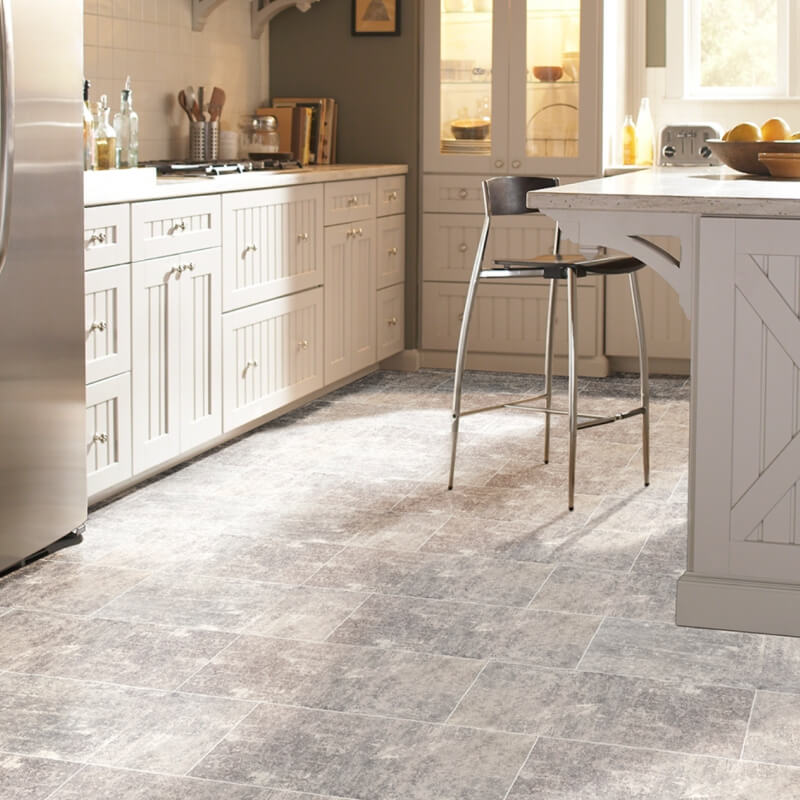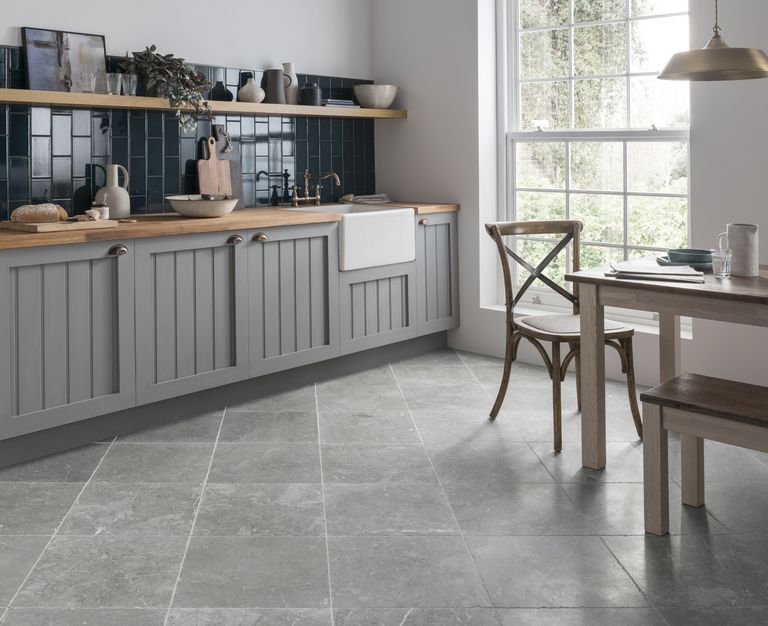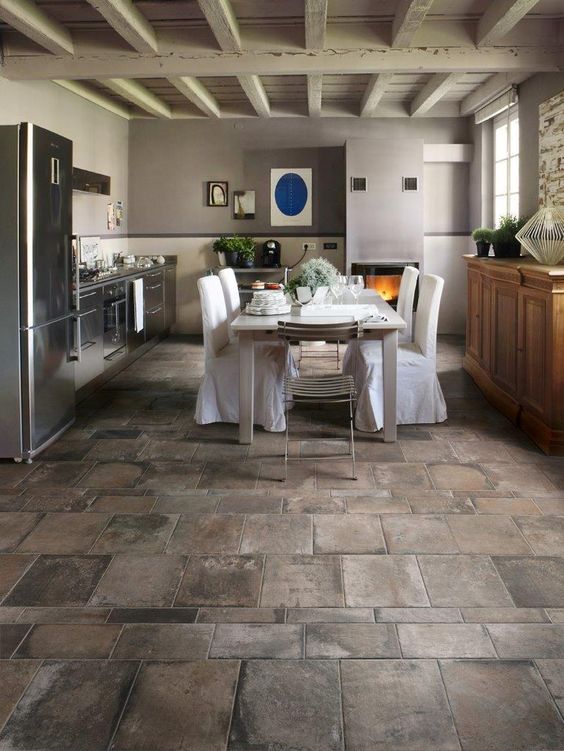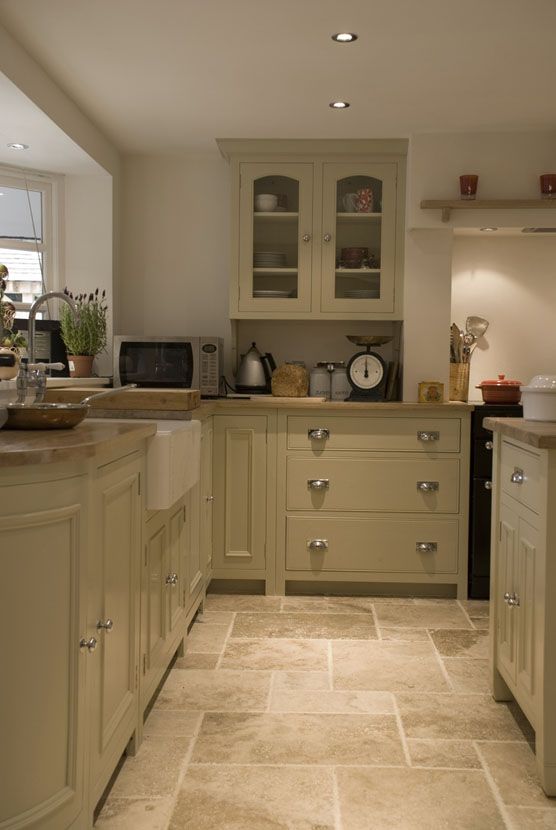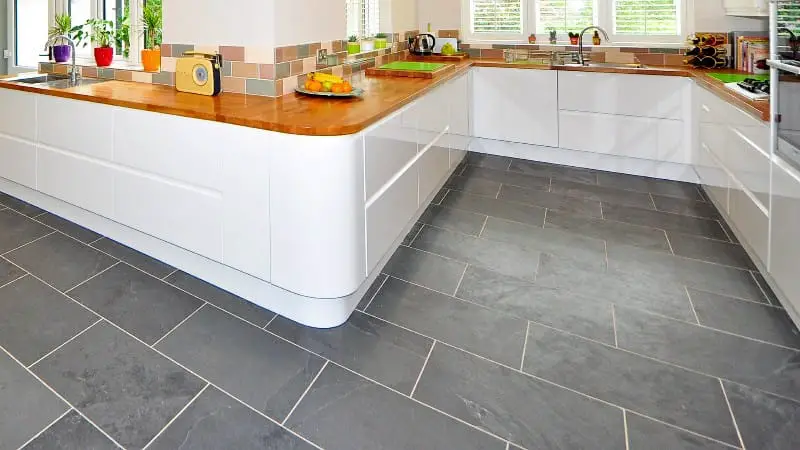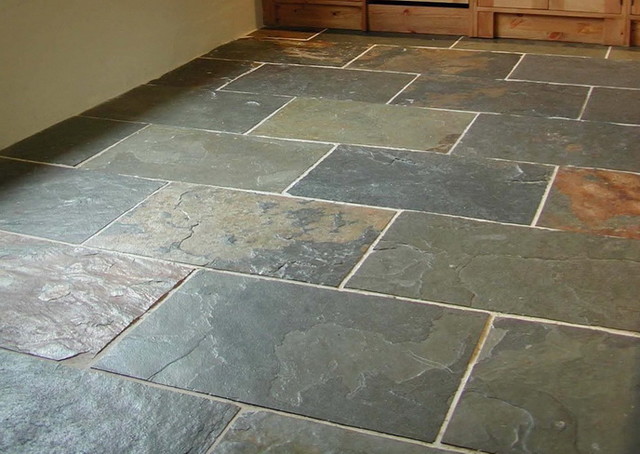Natural stone tile brings organic elegance and lasting performance to kitchen floors, combining practical functionality with unique aesthetic appeal. Unlike manufactured alternatives, each stone tile features distinctive variations in color, veining, and texture that add character to your culinary space. From the classic sophistication of marble to the rustic charm of slate, natural stone offers diverse options to suit various design preferences. Below, we examine six excellent stone choices for kitchen flooring, along with their maintenance needs and ideal applications.
Marble Tile – Luxurious Appeal with Practical Considerations
Marble flooring creates an instant sense of luxury with its elegant veining and polished finish. The cool surface feels pleasant underfoot in warm climates, while its light-reflecting properties brighten kitchen spaces. Popular varieties like Carrara and Calacatta offer different veining patterns, from subtle gray streaks to bold, dramatic swirls. However, marble’s porous nature requires prompt spill cleanup to prevent staining from acidic substances like wine or citrus juices.
While beautiful, marble ranks softer than other stones on the Mohs scale, making it more prone to etching and scratching. Honed finishes hide wear better than polished surfaces in high-traffic kitchens. Proper sealing upon installation and annual resealing maintains marble’s protective barrier. The stone’s thermal properties make it compatible with radiant heating systems, adding comfort in colder months.
Designers often recommend marble for kitchens where visual impact outweighs maintenance concerns. Pairing with area rugs in work zones protects vulnerable areas while showcasing the stone’s beauty in open spaces. Despite requiring more care than some alternatives, marble’s timeless appeal continues to make it a coveted choice for upscale kitchens.
Granite Tile – Exceptional Durability for Busy Kitchens
Granite stands as one of the hardest natural stones, resisting scratches, chips, and heat damage exceptionally well. Its speckled appearance hides crumbs and minor spills between cleanings, making it practical for active households. Available in both polished and honed finishes, granite tiles provide options for different aesthetic preferences and slip resistance needs.
Unlike marble, granite contains minimal pores when properly sealed, repelling kitchen liquids effectively. The sealing process should be performed during installation and refreshed every few years depending on usage. Granite’s natural variations ensure no two tiles appear identical, creating floors with organic visual interest. Darker granite varieties particularly conceal wear in high-traffic cooking areas.
Installation requires careful planning due to granite’s weight and the need for perfectly level subfloors. Professional installation ensures proper support and prevents lippage between tiles. While granite costs more than some options initially, its decades-long lifespan makes it a sound investment for homeowners planning long-term kitchen enjoyment.

Slate Tile – Rustic Charm with Natural Texture
Slate offers a distinctive cleft surface that provides excellent slip resistance, a crucial safety feature in kitchens. Its earthy color palette ranges from deep grays and blacks to subtle greens and rust tones, complementing both traditional and contemporary designs. The natural texture hides minor imperfections well, making slate forgiving in busy family kitchens where dropped utensils are common.
Unlike polished stones, slate’s matte finish doesn’t show water spots or footprints as noticeably. Its layered composition makes individual tiles slightly varied in thickness, requiring skilled installation for an even surface. Many homeowners appreciate slate’s ability to blend with outdoor stone elements when creating an indoor-outdoor kitchen flow.
Sealing enhances slate’s natural stain resistance while preserving its characteristic texture. While durable, slate can chip on edges if heavy objects are dropped, making area rugs advisable near appliance stations. The stone’s thermal properties help maintain comfortable temperatures, though radiant heating compatibility varies by slate type and thickness.
Travertine Tile – Old World Character with Modern Appeal
Travertine brings the warmth of Mediterranean villas to contemporary kitchens through its earthy tones and natural pitting. Available in polished, honed, and tumbled finishes, it offers design flexibility from sleek modern to rustic farmhouse styles. The stone’s natural pits and voids, often filled during processing, contribute to its authentic old-world charm.
While softer than granite, travertine resists heat well, making it suitable near ovens and cooktops. Its porous nature requires sealing to prevent oil and liquid absorption in kitchen environments. Honed finishes provide better traction than polished versions while maintaining the stone’s subtle sheen.
Travertine works particularly well in kitchens with Tuscan, Spanish, or French country design themes. The stone’s natural color variations help disguise wear over time, though acidic spills should be wiped immediately. Properly maintained travertine develops a desirable patina that enhances its character with age.
Limestone Tile – Subtle Elegance with Customizable Finishes
Limestone offers a softer, more uniform appearance than many natural stones, with gentle color gradations ranging from creamy whites to warm beiges. Its matte finish provides natural slip resistance while creating an understated, elegant backdrop for kitchen designs. Limestone can be honed, polished, or brushed to achieve different visual effects and textures.
More porous than granite, limestone requires thorough sealing and prompt cleanup of spills to prevent staining. The stone’s calcium carbonate composition makes it susceptible to etching from acidic substances, necessitating careful maintenance in kitchen environments. Lighter limestone varieties show less etching but may require more frequent cleaning.
Limestone works particularly well in coastal, cottage, or French-inspired kitchen designs where its soft appearance complements the aesthetic. The stone’s natural thermal properties keep floors comfortably cool in warm climates. While requiring more care than some alternatives, limestone’s serene beauty makes it worth the extra maintenance for many homeowners.
Soapstone Tile – Unique Patina Development Over Time
Soapstone stands apart with its smooth, almost soft feel and distinctive ability to develop a natural patina with use. The stone’s rich gray tones range from light silver to deep charcoal, often featuring subtle veining. Unlike many natural stones, soapstone is non-porous, making it resistant to stains without requiring sealing.
Initially appearing somewhat matte, soapstone gradually develops a sheen from regular use and occasional oil treatments. Minor scratches can be sanded out, and the entire surface can be renewed when desired. The stone’s heat resistance makes it ideal near cooking areas, as hot pans can be placed directly on its surface without damage.
Soapstone’s natural antibacterial properties and lack of required sealants make it hygienic for kitchen environments. While softer than granite, its repairability and unique aging characteristics appeal to homeowners who appreciate materials that tell a story over time. The stone’s subtle elegance works well in both modern and traditional kitchen designs.
Choosing and Caring for Natural Stone Kitchen Floors
Selecting the right stone involves balancing aesthetics, durability, and maintenance requirements. Consider your household’s cooking frequency and cleaning habits when choosing between high-maintenance stones like marble and more forgiving options like slate. Always view full-size samples in your kitchen’s lighting, as small swatches may not reveal the stone’s true character.
Proper installation prevents future issues. Stone tiles require sturdy, perfectly level subfloors to prevent cracking. Experienced installers understand how to handle natural variations in stone thickness and color. Expansion joints and appropriate grout choices accommodate the stone’s natural movement with temperature changes.
Daily care preserves stone’s beauty. Sweep regularly to remove abrasive grit, and clean with pH-neutral stone cleaners. Immediately wipe up spills, especially acidic substances like vinegar or citrus juices. Reapply sealant as recommended by the manufacturer or installer. With proper selection and maintenance, natural stone floors become enduring assets that improve with age.
Natural stone tile transforms kitchens into spaces of lasting beauty and functionality. Each type offers distinct advantages, from marble’s luminous elegance to soapstone’s evolving patina. By understanding the characteristics and care requirements of different stones, homeowners can select flooring that aligns with their lifestyle while creating a kitchen that feels both luxurious and welcoming.
Stone Flooring Ideas With Pros And Cons
Stone Flooring Ideas With Pros And Cons
What Is Natural Stone Flooring? Types, Pros & Cons, Cleaning
Travertine Kitchen Floor Design Ideas, Cost and Tips
Your Floor: How to Find Right Stone Tile
Related Posts:

